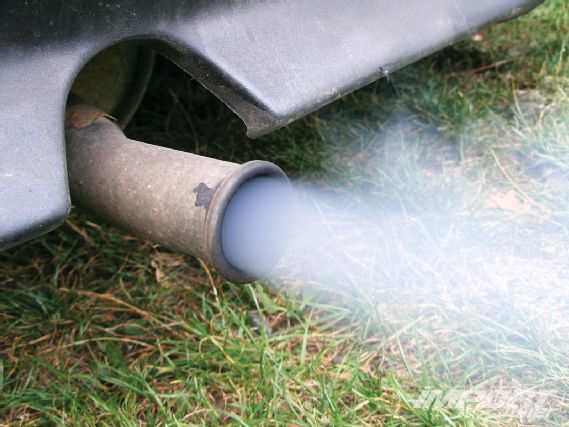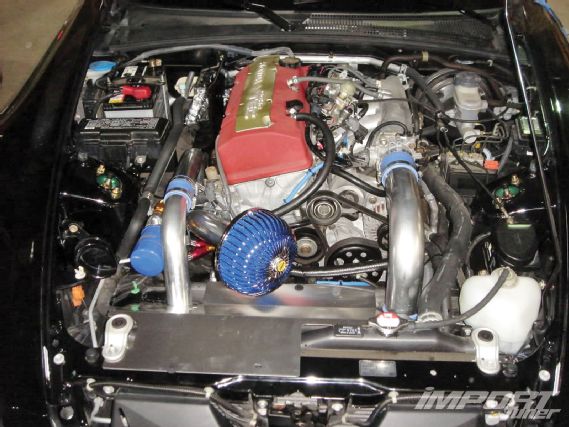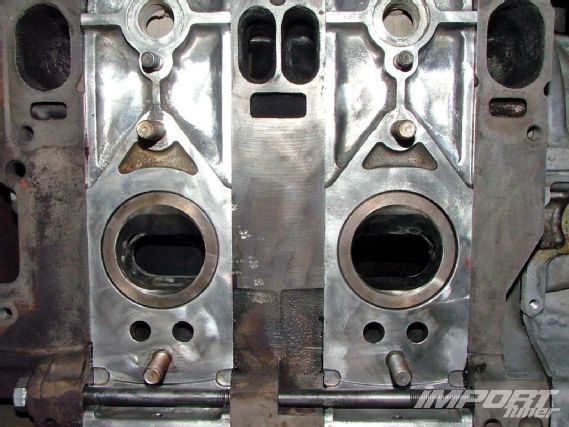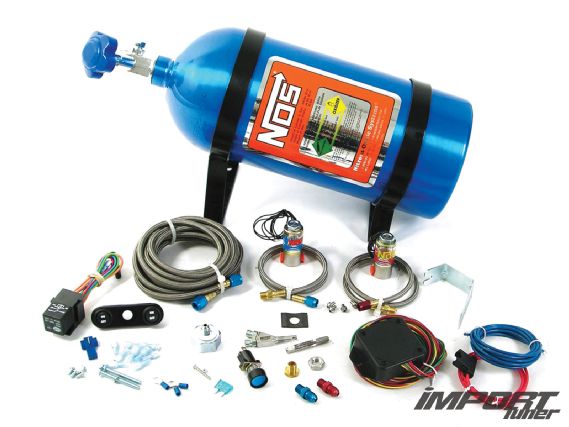 | Oil Consumption, Rotary Upgrades, Nitrous, E85, and More - Question It
| Oil Consumption, Rotary Upgrades, Nitrous, E85, and More - Question It
Got a burning question or simply need some advice with problems you’ve encountered while wrenching on your current/future projects? Ask our automotive guru Eric Hsu anything—literally, he’s going to answer every single question, as long as it’s automotive related.
Got a tech question? Send it to [email protected]
Oil Consumption
I own a ’02 Toyota Celica GT (five-speed) with TRD exhaust and AEM CAI. Recently, I have been experiencing issues with the motor, which has about 140K on the clock, beginning to consume oil along with a bluish smoke coming out of the exhaust. I assume the oil consumption is caused from burning oil, and the smoke is the result of oil blow-by from the piston rings. Of course, I am no expert but I experienced the same problem on another car I previously purchased. To make a long story short, the dealership replaced the rings, which cured the problem. How hard is it and what is involved in replacing the piston rings? Also, what tools and parts are required? I’m sure the head gasket needs to be replaced when opening the engine along with new piston rings.
 |
IMPP-121000-QUEST-018-021-
|
IMPP-121000-QUEST-018-021-
Johnny Balash
Wadsworth, Ohio
Oil typically enters the combustion chambers through worn piston rings/cylinder bores or leaky intake valve stem seals. In extreme cases, there could also be cracks in the cylinder head, but this usually only occurs on engines involved in accidents or extreme overheating. Blue smoke can also come from leaky exhaust valve stem seals with oil getting heated in the exhaust manifold or catalytic converter. A leakdown test should be able to help point you in the right direction. If it is valve stem seals, then they can be replaced without taking the cylinder head off the engine with some special tools.
If you need to replace the rings and that’s all you want to do, you can do this by dropping the oil pan and removing the cylinder head. You can remove the pistons from the top of the engine by unbolting the big end of the connecting rod and removing them from the bottom. Measure the bores to ensure there is no excessive cylinder wear using a dial bore gauge or at the very least a T-shaped snap gauge and a micrometer. Since the 1ZZ-GE engine has iron liners, you’ll need a BRM ball hone to “rough” up the cylinders so the new piston rings will break in correctly. You’ll also need some feeler gauges to measure ring endgaps. If the rod bearings are in good shape, you can reuse them or buy some new bearings from Toyota of the same grade (see the Celica service manual for this information). If your engine was burning oil in the cylinders, then you’ll also need to give the pistons a good cleaning since there will likely be a ton of burnt oil on them. You can use an overnight dip or some carburetor cleaner and some elbow grease to do this. Of course when you’re putting it all back together, you’ll need a brand-new head gasket and new cylinder head bolts. The Toyota 1ZZ has torque to yield bolts and should not be reused. Remember that you can never be too clean when building an engine. I’ve seen people put together engines without cleaning the parts or attention to detail with bad results. Attention to detail is what the best engine builders are good at.
Horsepower Potential
I’m looking into giving my Honda S2000 (AP1) some more horsepower. I’ve decided that I’m going for a turbo instead of a supercharger mainly for the fact that I’m a firm believer that turbocharging should be associated with import cars and superchargers belong on domestics, even though I know you can get more horsepower from a supercharger for the S2000s—but to each his own. I’m leaning toward a Greddy turbo kit, mainly because it’s CARB legal and a true bolt-on kit.
 |
IMPP-121000-QUEST-018-021-
|
IMPP-121000-QUEST-018-021-
I am aware that the Greddy kit isn’t the biggest turbocharger you can get due to the fact that more usable midrange power can be achieved with this type of turbo. The goal is to make anywhere between 400 to 500 street legal horsepower. What are your thoughts on the Greddy kit? From what I’ve read the Greddy kit can’t make those kind of numbers. I’m also looking into getting the ECS kit from Design Craft Fabrication to convert the F20C into iVTEC. I’ve heard that this kit improves midrange power as well, and I like the fact that it is a bolt-on system and I know I can do all the work myself.
Josh Alexander,
via importtuner.com
It’s important to remember that a CARB-legal turbo kit is designed around the confines of being smog legal, which means retaining the factory catalytic converter (not a high-flow aftermarket unit) and all other factory smog devices. For this reason, Greddy optimized the performance of their turbo kit around the factory smog components. The T518Z turbo features an 18G compressor section so it should be good for a solid 350 whp with a little more boost, proper tuning, and good parts selection. The Design Craft Fabrication ECS is a pretty trick piece, but requires a stand-alone AEM ECU or Hondata K-Pro conversion to control the iVTEC. Most of these mods can be done yourself with a complete set of tools and some elbow grease, but I would suggest the ECU tuning should be left to a professional if you’re not familiar with the process.
As for making 400-500 “street legal” horsepower that would depend on what state you live in. Some states have a looser definition of what “street legal” is. In California for example, this means CARB legal and not a single modification otherwise to the car. In Montana, “street legal” almost means as long as the car can drive on the street. A Full-Race S2000 turbo system with a “high flow” catalytic converter might be a good compromise if you aren’t too worried about the cops sweating you.
Mixology
I am currently building a GM (I know, sue me) 4.3L turbo motor. All the fuel injection is off a GMC Syclone. I plan on running a FAST BigStuff3 fuel management. What will be the best route to keep detonation down and octane levels up? I have narrowed it down to E85 and water methanol injection. What are your thoughts, and the pros and cons of both? I want streetability, but also to be able to keep the boost pressures up without issues.
Anonymous,
via importtuner.com
Are you sure you sent this question to the correct magazine? Oh wait, there aren’t any Syclone/Typhoon magazines, and your question is pretty general. E85 is a great fuel, but depending on where you live, fuel stations may have seasonal blends that can wreak havoc on a high-powered application. E85 can be anywhere between E70 and E85 and still be called E85 legally. The idea is that E70 provides easier starting in the colder winter months in states with brutal winters. I’m not sure if the FAST BigStuff3 has the feature for a Flex Fuel sensor or how fast the closed-loop lambda responds, but typically an ECU has to almost have both to allow an engine to live a long, happy life on E85 at high boost levels. Using a water and methanol mix for auxiliary injection is also a good idea to prevent detonation. Both methanol and water cool the charge temperatures down drastically allowing greater ignition advance and leaner fuel mixtures. The drawback is that there’s only a limited supply. If the ECU or meth injection system has a safeguard protection system that kicks the boost down or runs a different fuel/ignition map when there’s no more meth, then you’re in good shape.
Rotary Dilemmas
I own a ’88 Mazda RX-7 convertible that has 234K miles. I haven’t had any problems at all; the engine runs great; I perform most of the maintenance myself. This is my eighth RX-7. I previously owned a ’88 Turbo 2 model, and miss the feeling of forced induction, which brings me to the conclusion to supercharge my engine.
 |
IMPP-121000-QUEST-018-021-
|
IMPP-121000-QUEST-018-021-
First, I know that it is highly recommended that I do not supercharge an NA rotary engine, because of the high compression and that it’s a six-port. However, I believe that with the proper tuning it can be done. I have decided to go with a centrifugal supercharger due to the ease of installation. I am considering upgrading to either Turbo 2, or 13B REW fuel injectors and fuel pump, fuel pressure regulator, as well as porting the throttle bodies, and installing a true dual exhaust system.
Should I use a recirculating blow-off valve or atmospheric setup? Should I have my stock ECU tuned to support the upgrades or should I use a stand-alone ECU? What other modifications should I make? Do you recommend not supercharging my motor? Everybody is telling me to go with a Turbo 2 swap, but I would rather go with a supercharger, because the cost of having the swap done, buying the parts to support the swap, and the core charges are just too much for me to pay up front. It seems supercharging is cheaper in comparison (if it is done right). I am not looking to make insane horsepower; I would be very comfortable with 180 to 220 rear-wheel horsepower. I drive my car daily, mainly from Pasadena to Downtown Los Angeles and the canyons on weekends.
Desmond Marshall,
via importtuner.com
Supercharging an NA rotary can be done, and it has been done. If you search hard enough, you might be able to find a Nelson Mazda Supercharger kit. They used to be based in West Los Angeles right off Overland. The kit was discontinued long ago, but there are a few kits still floating around. The Nelson kit used a Paxton centrifugal supercharger. If you’re OK with a roots-type supercharger, then check out Camden Superchargers up in Washington. They have kits for rotaries of various configurations including six-ports.
If you are running the airflow meter, then you’ll want to recirculate the blow-off valve. If you end up running a stand-alone without an airflow meter, then you can run the blow-off valve dumping to atmosphere if you like. If you get sick of the noise, like I do, then you can also recirculate it.
The ’88 FC RX-7 factory fuel injection is terrible. I’m not sure if you want to spend too much time on it, but given your fairly low horsepower goals, it might be OK if you know somebody who knows how to tune them. Whatever you end up doing, just make sure you always run 91-octane and an intercooler if you want it to live another 200K!
Nitrous Friendly
I’m putting a 3SGE Beams (black-top dual VVTi) motor in my AE86 drift car. The engine is going to be NA, and I want to run at least a 50hp shot of nitrous oxide, possibly a 100hp shot along with E85 fuel. I haven’t heard anybody combine both nitrous and E85. Can they be combined? Before you ask why I am running E85, my answer is that the engine is high compression, and I don’t want to spend a lot of money on race fuel.
 |
IMPP-121000-QUEST-018-021-
|
IMPP-121000-QUEST-018-021-
Anonymous,
via importtuner.com
Yes, nitrous and E85 can be combined without any unusual problems. I would recommend you run a direct port kit (one nozzle per cylinder) if you plan on running anything over 50 hp. Intake manifolds were never designed to distribute a highly pressurized fog of nitrous and/or fuel. A direct-port system will prevent melted pistons due to nitrous/fuel distribution issues. Also, I’d recommend a bottle heater and bottle blanket for a couple of reasons: to get the most use out of each bottle and to get more consistent performance. One of the struggles of using nitrous on a regular basis is inconsistent bottle temperature. You probably learned in high school that the higher the temperature, the higher the pressure of a gas. Hitting the nitrous system on a 95-degree F day on a nitrous system tuned on a 65-degree F day can have disastrous results. Don’t skimp, get the right parts, and you’ll have a blast on nitrous... in your engine that is.
